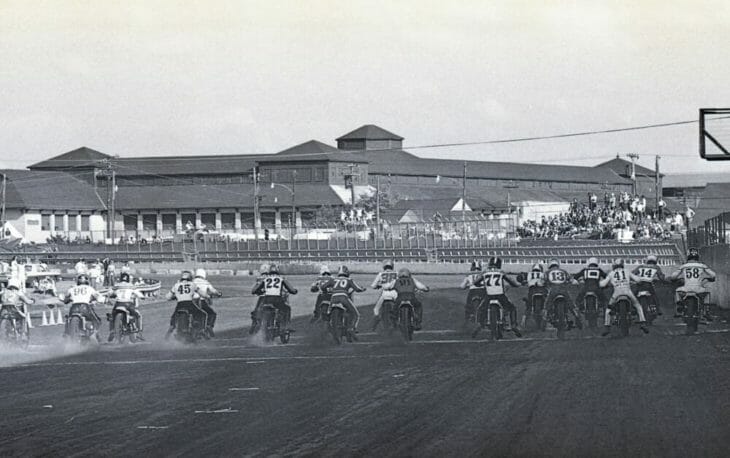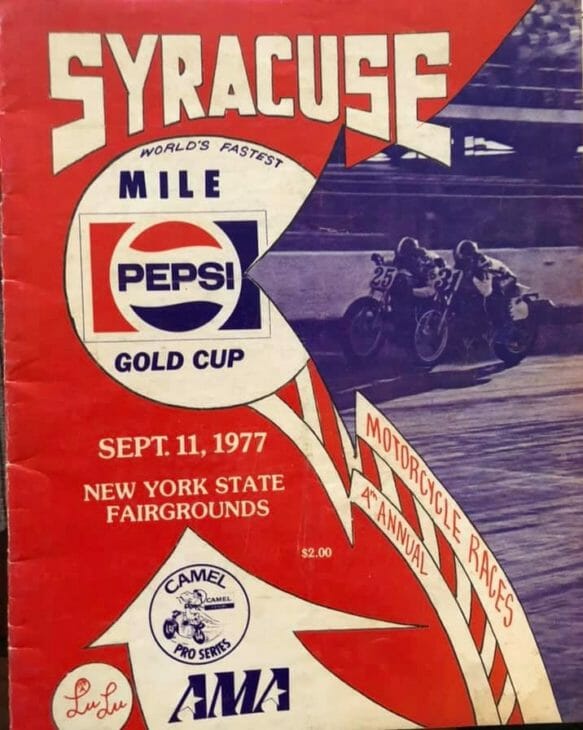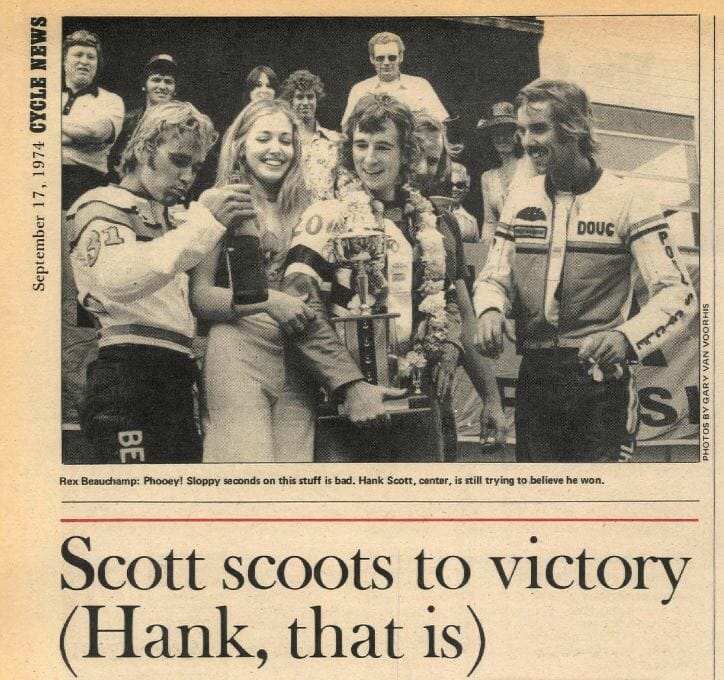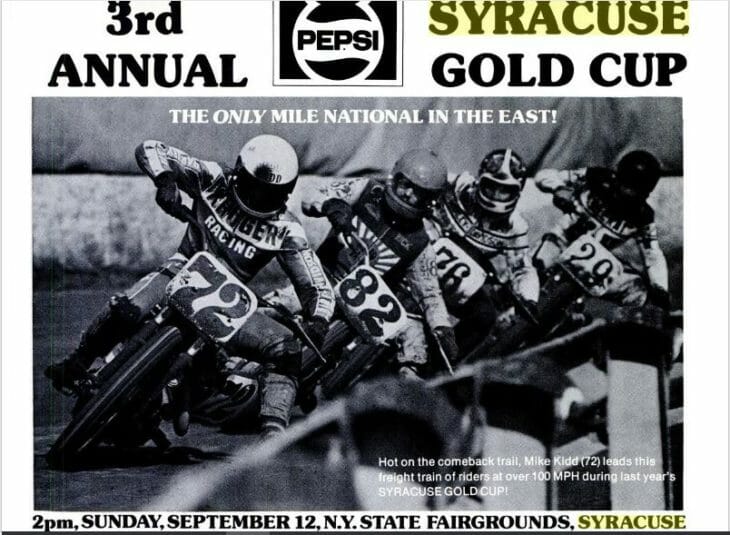Larry Lawrence | January 15, 2019
Archives: Missing Syracuse
It’s gone now – the victim of progress and the construction of new buildings on the site. The Syracuse Mile was torn down a couple of years ago and this past summer a sparkling new $63 million Expo Center was opened on the site of the historic track at the New York State Fairgrounds. There were few racing facilities in the country that had the kind of history that the Syracuse Mile boasted. Racing fans will long lament to passing of this great racing venue, but in this week’s edition of Archives we’ll attempt to honor the track by looking back with a snapshot of its rich history.
Archives: Missing Syracuse
 A start at the 1975 Syracuse Mile. (Gary Van Voorhis photo)
A start at the 1975 Syracuse Mile. (Gary Van Voorhis photo)
Nearly all of the greats of the first couple decades of American motorcycle racing raced at the Syracuse Mile. Motorcycle racing’s in this country evolved out of New York and Massachusetts and there’s good evidence that the Syracuse Mile was perhaps the birthplace of what we know today as flat track racing.
The Syracuse Mile dates back to the very beginning of motorsports. In 1900 a $10,000 bid was awarded to build a dirt track suitable for auto racing on the perimeter of an existing harness track. Not long after being built motorcycles began running on the Syracuse Mile. Syracuse also established one of the earliest motorcycle clubs in America and the club hosted races on the Mile that drew crowds as large as 30,000. Easily the biggest news in those early years was when in 1904, motorcycle maker and racer Glenn Curtiss, from Hammondsport, NY, raced a twin-cylinder Curtiss around the mile in 61 seconds, just missing the then mythical mile a minute.
Curtiss’ highly-publicized run at Syracuse instantly made the track known throughout the nation. With races held during the famous New York State Fair, not only did the Mile attract big crowds, but some big names as well. In 1908 Motorcycle Illustrated reported that Vice President James Sherman was among those who attended the races that year. That kind of news exposure for the track helped Syracuse become host of early FAM and M&ATA National Championship events. From the start motorcycle racing drew large crowds at the Syracuse Mile and that was another reason the FAM (predecessor to the AMA) elected to host national races there in 1910s.
 The program for the 1977 Syracuse Mile. (Courtesy Jim Malyj)
The program for the 1977 Syracuse Mile. (Courtesy Jim Malyj)
Hall of Famer Fred Ludlow made his name as one of the biggest stars of the sport when on September 19, 1921, on the famous Syracuse (New York) Mile, Ludlow earned a clean sweep of all the national titles up for grabs. Ludlow was a perfect five wins in five races on his factory Harley-Davidson, besting most of the top stars of the day, including the likes of Jim Davis, Don Marks, and Ralph Hepburn. It was one of the most dominant performances in the history of the sport.
Ludlow’s popularity was such after Syracuse, that Harley-Davidson employed him to travel the country in a sidecar to host racing film shows to various clubs and other organizations interested in the sport.
Throughout the 1920s Syracuse hosted among the biggest motorcycle racing events, where elite riders like Jim Davis, John Seymour, Ralph Hepburn, Gene Walker, Joe Petrali and Curley Fredericks won major titles. It was also the site of some of the most intense battles between the Harley and Indian factory teams. Both squads would bring out all their big guns and often supply factory bikes to additional riders to stack the deck for Syracuse.
Joe Petrali was another rider who made his name at Syracuse. Petrali practically owned the track throughout the 1930s, winning dozens of national titles there during that decade.
 Cycle News coverage of the historic return of the Syracuse Mile in 1974, won by Hank Scott.
Cycle News coverage of the historic return of the Syracuse Mile in 1974, won by Hank Scott.
The Syracuse Mile also happened to be one of the final tracks that continued to host Class A races (super-tuned factory bikes) well into the Class C (production bikes) era. The last major Class A Championship event was held at Syracuse in 1938, but by then the factory specials of the early ‘20s that were still being raced were just about museum pieces by then – with the exception of the British-made JAP-powered machines which won most of the races in the mid-to-late ‘30s. By that point Class A was mostly for the old timers hanging on to the memories of the first generation of American motorcycle racing. The real momentum and youthful excitement in the motorcycle racing by the late ‘30s had long since moved to the production bikes of Class C.
In 1939 the comparatively big, heavy and slower machines of Class C were finally featured at Syracuse. Reading, Pennsylvania rider Lester Hillbish scored the victory that year on a Sport Scout ahead of fellow Indian riders Stan Witinski and Ed Kretz. Hillbish’s run broke an AMA speed record for a 50-mile event and his mark would hold well into the 1950s. Indian swept the first five place at Syracuse in ‘39, with the top-placing Harley ridden by Babe Tancrede in sixth.
The ’39 edition of the Syracuse Mile was the last one until after World War II. Bobby Hill kept Indian’s domination of the track alive with his victories in 1952 and ’53. And then the race was bizarrely off the calendar after ’53 not to return for over 20 years.
 An ad for the Syracuse Mile boasting the race as the only Mile in the East.
An ad for the Syracuse Mile boasting the race as the only Mile in the East.
Syracuse returned in 1974 to great fanfare and 10,000 fans, in spite of thunderstorms across the region. Rookie Expert Hank Scott took the victory in the return race over fellow Harley riders Rex Beauchamp and Doug Sehl.
Promoters of Syracuse were also one of the first to begin the tradition of bringing back old racers to honor them. In 1987, Woodsie Castonguay, a star from the ‘30s, was honored as Grand Marshall of the Gold Cup Mile National at Syracuse.
Movie maker Peter Starr filmed at Syracuse in 1975 and then again, a decade later, when the race was part of the Stroh Miles. Fans seeing Syracuse on film only added to the prestige of the event.
The Syracuse Mile had some quirks that made it challenging for riders. Turn one was broad and often offered multiple racing lines, but the track tightened up in turn two with riders saying the outside wall closed in on you fast. Turns three and four formed a completely different racing line than one and two. And then there was the hump on the front straight that could get the front end of the bikes light and sometimes cause a high-speed wobble.
Syracuse was the host of back-to-back doubleheader nationals in 1992 and ’93.
Jay Springsteen got along well with Syracuse and won there four times in the ‘70s and ‘80s. Bubba Shobert was also a four-time winner. Ricky Graham scored three, including sweeping the doubleheader in ‘93. Surprisingly, all-time AMA Grand National Mile King Scott Parker only managed a single victory there – that came in 1992. Chris Carr won what turned out to be the final national held there in 2005, following another lengthy 12-year gap between Syracuse Miles.
The Syracuse Mile was one of those races that produced great loyalty. Faithful fans endured rain-outs, cancelations and long days waiting out weather, but still they came back year after year. Some say it was the aura of the place that won them over. In spite of efforts of preservationists, the track was torn down in 2016, with the old grandstands imploded. You can watch that if you care to on You Tube.
While the track is now in the record books, it will live long in the memories of the riders and fans who for decades enjoyed their annual trek to Upstate New York.